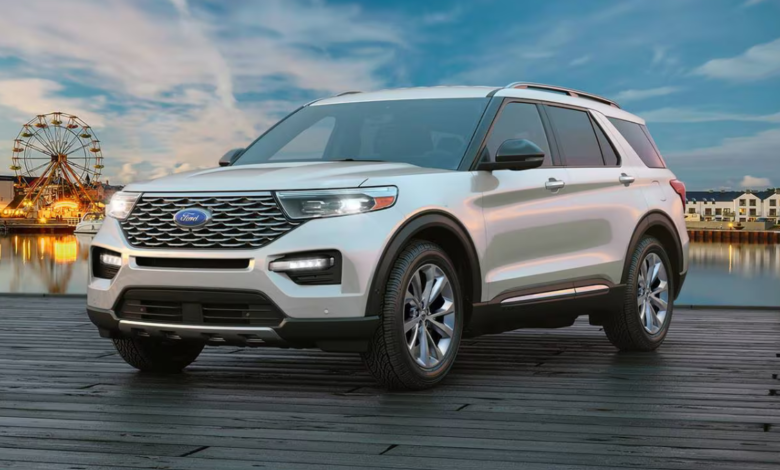
The Ford Explorer has been integral to suburban American life for thirty years since its first in 1991. Its sixth-generation model, which debuted in 2020, is still in production for 2023. Ford still sells a lot of them, primarily because of their adaptability. In its most basic form, it’s just a modernized take on the classic family station wagon. Still, it can also be ordered as the performance SUV ST version or the light-off-road Timberline version, and an Explorer version specifically for fleets, law enforcement, and first responders is also available.
The Explorer is offered in eight trim levels for 2023. At $38,335 (plus a $1,595 destination charge), the Base model is the least expensive. Other models that are priced higher are the XLT ($40,165), ST-Line ($47,600, new for 2022), Limited ($48,665), Timberline ($50,575), performance-focused ST ($51,600), Platinum ($56,060), and the opulent King Ranch ($57,125 including destination fee).
Even though it practically created the four-door, midsize SUV market class at an inexpensive price, rivals quickly entered the fray. The cars that comprise the current pack include the Hyundai Palisade, Kia Telluride, Chevrolet Traverse, and Toyota Highlander. The names have varied throughout the years. The Explorer is comparable to most competitors in size, internal room, fuel efficiency, and performance. However, it differs somewhat in one key area: engine selections.
There are three main powerplant options for the Explorer. Customers purchasing an Explorer have the option of an EcoBoost four-cylinder engine with 300 horsepower (standard on Base, XLT, ST-Line, Limited, and Timberline models), an EcoBoost V6 engine with 400 horsepower (standard on ST, Platinum, and King Ranch models), or a 318 horsepower 3.3-litre hybrid engine (optional on Limited models only). By comparison, the Palisade and Telluride have 291 horsepower, while the most powerful option available for the Traverse is a 310 horsepower V6. The ten-speed automatic gearbox enhances fuel efficiency ratings mated to all engine choices.
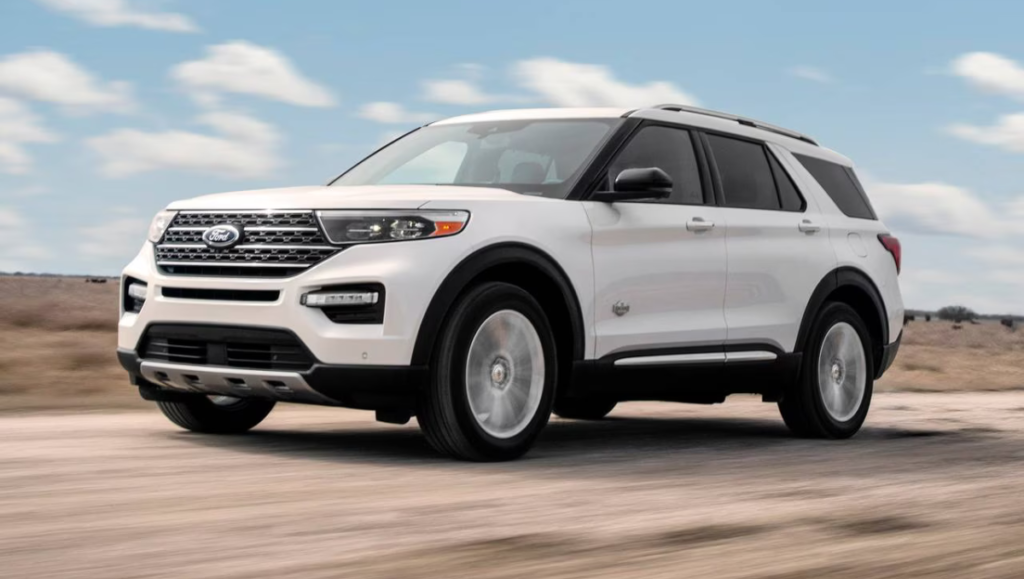
The Explorer’s readily changeable interior is one reason for its endurance. 18.2 cubic feet of cargo space are located behind the third row of seats, and there is space for seven passengers—as long as the people in the third row are amiable and compact. Do you need to move anything? With the second and third seats folded flat, the load area is 87.8 cubic feet. The roof rack can hold skis, kayaks, and other outdoor equipment, and when correctly outfitted, it can pull up to 5,600 pounds. Cons: Compared to the Palisade, the inside seems a touch old-fashioned.
All Ford vehicles come with the Co-Pilot360 safety suite as standard. Essential safety features, including automated high beams, lane-keeping assistance, blind spot warning, frontal collision warning with automatic emergency braking, and pedestrian recognition, are all included. Even though Android Auto and Apple CarPlay are standard on every model in the lineup, if you want the safety features and some of the more cutting-edge tech included in the Ford Co-Pilot360 Assist+ package, we recommend starting with the Limited rather than spending a lot of time poring over the option sheet.
Performance: Ford Explorer
Three engine options are available for the Explorer: a 3.0-litre EcoBoost V6 rated for 400 horsepower in the performance-oriented ST model, a 2.3-litre EcoBoost inline-four good for 300 horsepower, and a 3.3-litre hybrid good for 318 combined horsepower. The four- and six-cylinder engines’ turbocharging and the hybrid’s electric aid enable them to accelerate livelily and with enough power for manoeuvres on and off the highway.
Rear-wheel drive is standard on the 2.3-litre four-cylinder and the 3.3-litre hybrid engines; 4WD is optional. For the Timberline and variants with the 3.0-liter EcoBoost V6, 4WD is standard. All models come with a ten-speed automatic gearbox, but the hybrid receives a customized model to enable a more seamless fusion of the electric and gasoline powertrains.
Handling is respectable for a midsize SUV and far better than Explorers from a few decades back. Although the normal powertrains function discretely, the hybrid model’s gearbox sometimes seemed confused. The two power sources weren’t seamlessly integrated, as in other hybrids, and shifts might be clumsy and sluggish. However, it might be an Explorer hybrid operating trait since rivals like the Highlander Hybrid employ a CVT instead of a standard automatic.
The maximum weight models can tow with the EcoBoost V6 engine and four-wheel drive is 5,600 pounds. Although the Timberline does provide a little bit more off-road flair, especially on slick gravel, light snow, and forest roads, it will never be able to compete with the off-road capabilities of the Ford Bronco or the Toyota 4Runner.
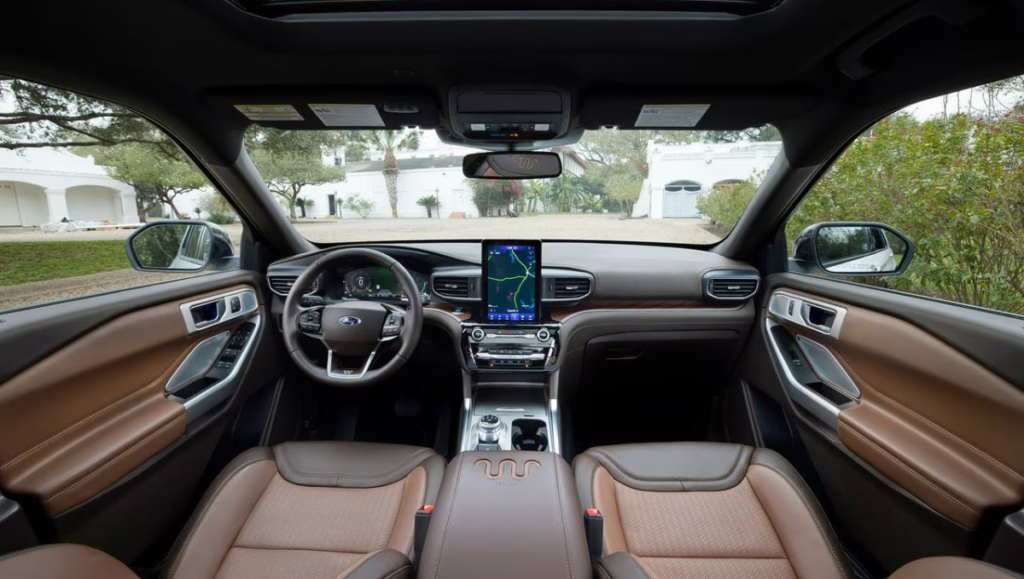
Fuel Efficiency: Ford Explorer
The Explorer’s fuel efficiency ratings are average for the class. According to the EPA, the average fuel efficiency ratings for the Explorer family, including all-wheel drive and rear-wheel drive versions, are 19 mpg in the city, 25 mpg on the interstate, and 21 mpg overall.
That is comparable to other models, such as the Hyundai Palisade, Kia Telluride, and Chevrolet Traverse. The Traverse gets 18 city, 26 highway, and 21 combined miles per gallon. The ratings for the Palisade are 19 mpg in the city, 25 mpg on the interstate, and 22 mpg overall. Very comparable mileage is seen in Kia’s Telluride, which gets 20 mpg in the city, 25 mpg on the interstate, and 22 mpg overall.
The most fuel-efficient Explorer is the hybrid, with an EPA rating of 27 mpg combined, 23 mpg in the city, and 28 mpg on the highway (or 23, 23, and 24 if all-wheel drive is used). The 3.0-litre V6 is rated at 21 mpg combined on 18 cities and 26 highways, while the turbo four achieves a top of 24 mpg combined on 21 towns and 28 streets. In every case, an all-wheel drive system somewhat lowers economy; the Timberline, on the other hand, gets a few more miles per gallon because of its taller profile, more aggressive tires, and other elements.
Driver assistance and safety:
The Ford Explorer receives the best safety rating from the Insurance Institute for Highway Safety (IIHS), a Top Safety Pick+: The Explorer does not have a frontal collision rating or an overall crash rating from the National Highway Traffic Safety Administration (NHTSA). Nonetheless, the NHTSA has sufficient information to give it a four-star rollover rating and a five-star side crash rating.
Forward collision warning with automated emergency braking and pedestrian recognition, post-impact braking, blind spot warning with cross-traffic warnings, lane-keeping assistance, hill start assistance, and automatic headlamps with automatic high beams are all included in the standard Co-Pilot360 safety package.
Various functions are added to the standard safety package with the optional Co-Pilot360 Assist+ package (available on XLT grade and higher), including evasive steering aid, lane-keeping assistance, and adaptive cruise control with stop-and-go.
Front, side, and knee airbags for front-row passengers are standard equipment. Safety canopy side-curtain airbags, which cover all three rows and activate in the event of a rollover, are also included.
Coziness & Space:
Explorers have always been spacious and comfortable, and the new model is on par with the competition. With 43 inches of front legroom, it is slightly more than the Telluride (41.4 inches) and the Traverse (41.0 inches). The second row sees a tiny script flip: the Explorer’s 39 inches of legroom is a little more remarkable than the Traverse’s 38.4 inches, but it still lags behind the Telluride (41.4) and Palisade (42.4).
The Explorer outperforms the Telluride and Palisade (all provide 31.4 inches) in third-row legroom with 32.3 inches, while the Traverse excels with 33.5 inches. With 33.7 inches, the Volkswagen Atlas has even more. Notably, the third-row cushions on the Explorer are the firmest, which makes it unpleasant for extended journeys.
That is untrue for the front passenger seat, the driver’s seat, and the outboard second-row seats, which are all supportive and comfy. The second row’s centre seat seems composed of more challenging material and is rather unpleasant.
On the Limited trim level and above, leather seats are standard. The front row has heated and ventilated seats, while the second row has heated seats. The XLT and base versions come with fabric.
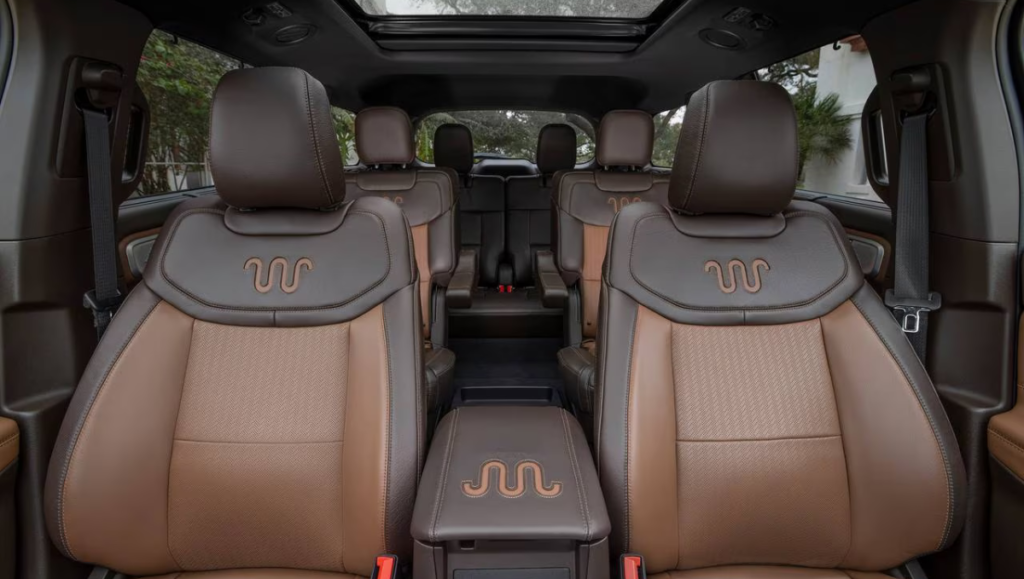
Infotainment: Ford Explorer
The Base model has a 4.2-inch screen integrated into the instrument cluster and houses the trip computer, outdoor temperature monitor, and onboard messaging centre. The centre stack’s 8-inch touchscreen has many uses and works nicely with the standard Android Auto and Apple CarPlay systems. There are two USB ports in the front row.
The instrument display on the XLT trim is more prominent at 6.5 inches, and in the ST variant, it rises to an astonishing 12.3 inches. Additionally available to ST purchasers is a 10.1-inch touchscreen for the central stack.
There are actual knobs and buttons in addition to the touchscreen, which may be used to manage the music and heating/cooling systems. As a result, adjusting the screen without going into settings is significantly more straightforward.
Storage & Cargo Space:
The Explorer excels in load capacity, with a flat cargo floor made possible by the second and third rows that fold flat. It boasts a larger cargo capacity than the Kia Telluride or Hyundai Palisade, with 18.2 cubic feet behind the third row, 47.9 behind the second, and 87.8 cubic feet with the third and second rows folded. Chevy’s Traverse, undoubtedly more considerable outside altogether, wins nonetheless, with an astounding 23 cubic feet behind the third row, 57.8 behind the second, and 98.2 overall.
Numerous compartments and storage boxes for more miniature goods, such as phones, wallets, and handbags, are in the passenger cabin. AmplThere is ample storage space in the centre console and a tray to hold loose change and other small objects.
Design: Ford Explorer
The Explorer has long been a feature of the American environment. It is a best-seller for Ford and well-liked by law enforcement agencies and the general public. Driving the Explorer shouldn’t draw attention unless you happen to be mistaken for a member of the local police enforcement. Although it’s a good car, it gets lost in the sea of vehicles on the road.
It’s not meant to pamper the passengers with the opulent luxuries you’d expect in a more costly or high-end SUV while being sturdy and well-built. This workhorse fulfils the expectations of usefulness and strength. Thanks to the Explorer’s luggage capacity and towing capabilities, it will transport seven travellers to their destination while enabling them to carry everything they need.
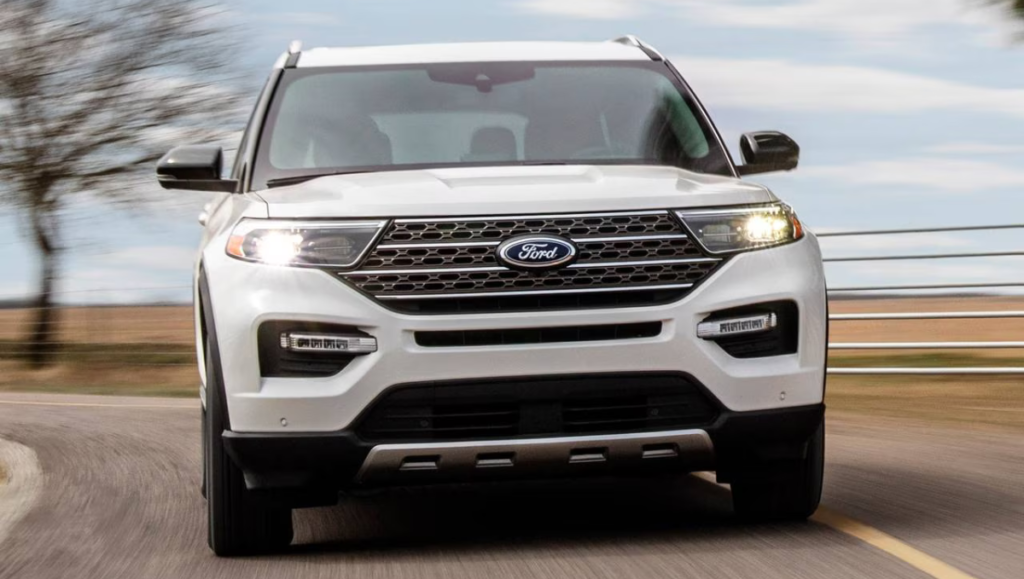
Is the Ford Explorer 2022 a Good Buy?
There is an Explorer trim level to suit every need, want, and budget since eight are available. Although the Base model has a starting price of an alluring $38,335 (plus a $1,595 destination fee), it lacks many of the modern conveniences and creature comforts that most drivers want in a car.
The King Ranch variant has a sticker price of $56,315 (including the destination charge) and is at the opposite end of the scale. Although it is good to have many luxury features, you are not getting the most out of this car.
The Limited model costs $48,655 with delivery and is the best deal. Now, leather seats are preferred over fabric ones, and the leather is vented and heated. Furthermore, you’re enjoying extra amenities like the Ford Co-Pilot360 Assist+ package’s enhanced safety functions, a heated steering wheel, ambient lighting, a surround-view camera, and a 12-speaker Bang & Olufsen sound system.
How Much Does Ford Explorer Insurance Cost?
The Explorer’s insurance premiums are somewhat more than those of the competitors. An average yearly premium for a 30-year-old female driver with a clean record is $2,129. Conversely, the average cost of insurance for the Chevrolet Traverse is $2,095; for the Hyundai Palisade, it is $2,025, and for the Kia Telluride, it is $1,985.
Ford Explorer Generations
Sixth Generation
2020 to Present
For the 2020 model year, the sixth-generation Explorer made its appearance.
Fifth Generation
2011 to 2019
The fifth-generation Explorer has a Terrain Management System and a redesigned unibody design. A new 2.0-liter EcoBoost engine was released.
Fourth Generation
2006 to 2010
For the 2006 model year, Ford debuted a new 4.6-litre V8 engine mated to a 6-speed automated gearbox in addition to standard electronic stability control. A power-folding third row of seats and other interior upgrades were also included.
Third Generation
2002 to 2005
The third-generation Explorer had a lower frame height and was more extended and broader. To increase comfort, a brand-new independent rear suspension was installed. Along with these firsts for the industry, the new Explorer had rear entertainment, a third row, and a new V8 engine.
Second Generation
1995 to 2001
The external design of the second-generation Explorer was revised. For the 1996 model year, a new V8 engine option was introduced. In 1997, a new V6 engine followed suit. In 1999, front and side airbags were made standard.
First Generation
1991 to 1994
With a 4.0-liter V6 engine, the first-generation Explorer SUV made its model year 1991 premiere. It came as a four-door or two-door Sport variant, seating six people.

Verdict
Consider the Ford Explorer SUV of 2023 as a clean slate. With eight model levels, two gasoline engine options, a hybrid drivetrain, and rear-wheel or four-wheel drive, consumers can easily customize an Explorer to suit their needs. The Platinum model aims for a luxurious feel, the Timberline leans toward outdoor preferences, and the base variants are great family movers. All three engines have competitive fuel efficiency figures and are solid and responsive. It sits in the middle of the midsize SUV market because of its seven seats, class-competitive load capacity, and 5,600-pound towing capacity.




